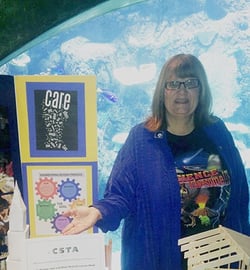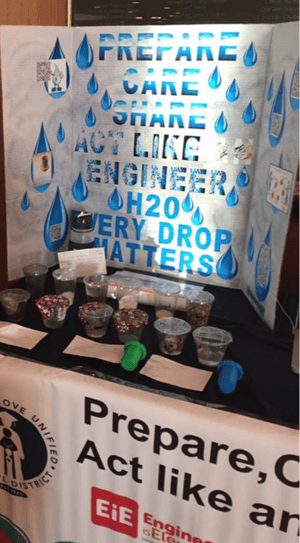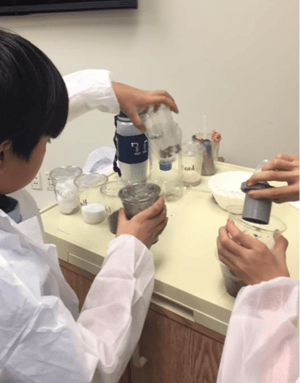 Solving food scarcity. Preventing viral outbreaks. Designing buildings to withstand natural disasters. Through Engineering Adventures and Engineering Everywhere, learners across the country have proposed unique, data-driven solutions to some of the world’s most pressing problems. These flexible curricula were tested in afterschool and summer programs, but classroom educators across the country have been implementing them into their STEM instruction for years. Just ask Camie Walker, the Utah educator who was featured on our blog in 2016 for her incredible work with the Engineering Adventures unit Shake Things Up: Engineering Earthquake-Resistant Buildings. She chose units from EiE’s flexible curricula because she loves creating opportunities for learners to connect what they’re learning to the world around them and to follow their STEM interests and passions.
Solving food scarcity. Preventing viral outbreaks. Designing buildings to withstand natural disasters. Through Engineering Adventures and Engineering Everywhere, learners across the country have proposed unique, data-driven solutions to some of the world’s most pressing problems. These flexible curricula were tested in afterschool and summer programs, but classroom educators across the country have been implementing them into their STEM instruction for years. Just ask Camie Walker, the Utah educator who was featured on our blog in 2016 for her incredible work with the Engineering Adventures unit Shake Things Up: Engineering Earthquake-Resistant Buildings. She chose units from EiE’s flexible curricula because she loves creating opportunities for learners to connect what they’re learning to the world around them and to follow their STEM interests and passions.
We sat down with Walker to learn how she uses flexible curricula to foster an inquiry-based, globally focused culture in her classroom that leads to plenty of real-world connections, and even the chance to perform with a Mythbuster!
Here are her lessons for success:
1. Start with standards and keep connecting
The NGSS Lesson Screener suggests that rather than teaching engineering as a collection of trial-and-error, one-off activities, quality engineering lessons should “require students to acquire and use elements of disciplinary core ideas from physical, life, or Earth and space sciences together with...engineering design to solve design problems.”
Walker agrees with this assessment. “It’s critical, in this day and age...that our kids understand science by doing it, and not just by reading about it,” she says. “[EiE] is a way to do both.”
She connects Engineering Adventures and Engineering Everywhere units to Utah’s science topics, such as Earth science and properties of matter, but she also makes room for literacy and social studies connections, like opinion writing about the complex issues underlying Shake Things Up.
“I get really tired of having kids write about white milk vs. chocolate milk,” she jokes. “They don’t care! But when they’re researching building codes and writing about why homes are destroyed in Haiti...and why 10 years later, there’s still debris, and people are still homeless...now they’re going into political aspects that matter. It’s really cool and impactful.”
2. Let your learners’ interests guide you
 Walker’s students are passionate researchers and curious about where the technologies they design could be used to help people. She fosters their interests and makes an effort to connect their ideas to other lessons in her classroom and beyond.
Walker’s students are passionate researchers and curious about where the technologies they design could be used to help people. She fosters their interests and makes an effort to connect their ideas to other lessons in her classroom and beyond.
“When you have [curricula like] Engineering Adventures and Engineering Everywhere, you have more flexibility,” she says. “You have a little bit more freedom to go into these other directions, which is kind of powerful.”
When Walker was teaching Shake Things Up in her former school in California, her student researchers discovered that water contamination and drinking water shortages were a huge and underreported danger in Haiti after the devastating 2010 earthquake. Walker channeled students’ concern into action by connecting into the Engineering is Elementary unit Water, Water Everywhere: Designing Water Filters.
To really prompt her students’ investigative instincts, Walker created a math extension to chart water contamination across the globe. Studying the data, students began to brainstorm how they might help bring more potable water to remote regions of Africa. The school’s new 3D printer inspired one group to imagine how 3D printed filter materials might help, and they created “The Two Drop Campaign,” inspired by the knowledge that only two percent of the world’s water is drinkable.
Their innovation didn’t go unnoticed: Adam Savage, formerly of the TV show Mythbusters, invited them to present their campaign at his live show, Brain Candy. He was so impressed, he asked them to return to talk about renewable energy at a later show.
“It is amazing. It creates student buy-in because students want to buy in. They want to have things that are relevant…[they want to] look at real-world problems and find solutions,” says Walker. “That’s empowering.”
3. Empower learners to see themselves as capable problem solvers
 Walker continually encourages her students to look at problems in their world and imagine how they could help those who need it most (check out our 2016 blog about her class’s work with Hope for Haiti). This not only fosters her learners’ civic engagement and global awareness: Walker says it also brings them strength in an uncertain world.
Walker continually encourages her students to look at problems in their world and imagine how they could help those who need it most (check out our 2016 blog about her class’s work with Hope for Haiti). This not only fosters her learners’ civic engagement and global awareness: Walker says it also brings them strength in an uncertain world.
“The human impact is in every one, and that's the part that gets the kids excited. And I also think it empowers them,” she says. “Because we live in a really scary world, and it's going to be scary for them no matter what. But if there are ways that they can make connections that are global, that they can solve these problems, then they begin to realize that they do have control. And it makes scary things a lot less scary.”
We can’t think of a better reason to empower a generation of problem solvers to tackle today’s most pressing problems with creativity and compassion.
If you’d like to try out Engineering Everywhere, download a sample activity and start making a difference in your classroom today.









